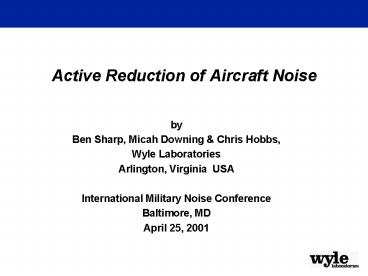Active Reduction of Aircraft Noise - PowerPoint PPT Presentation
1 / 15
Title:
Active Reduction of Aircraft Noise
Description:
Low-frequency noise from ground run-up operations is a major source of community ... Enclosures, or hush-houses, are expensive and often inconvenient to use, and are ... – PowerPoint PPT presentation
Number of Views:86
Avg rating:3.0/5.0
Title: Active Reduction of Aircraft Noise
1
Active Reduction of Aircraft Noise
- by
- Ben Sharp, Micah Downing Chris Hobbs,
- Wyle Laboratories
- Arlington, Virginia USA
- International Military Noise Conference
- Baltimore, MD
- April 25, 2001
2
Characteristics of Low-Frequency Aircraft Noise
- At Low-Frequencies (lt 160Hz) aircraft noise
- Radiates mainly to the rear of the
- aircraft.
- Attenuates slowly with distance.
- Passes easily over barriers
- and berms.
- Transmits well into buildings.
- Causes rattle of windows and
- internal objects.
3
Specific Problem Areas
- Ground Run-ups
- Low-frequency noise from ground run-up operations
is a major source of community annoyance. - Maintenance run-ups occur during the nighttime
hours - Enclosures, or hush-houses, are expensive and
often inconvenient to use, and are not suited to
airports with only localized problems. - Departing Aircraft
- Low-frequency noise to the rear of departing
aircraft can be almost continuous during busy
periods.
4
Passive vs Active Noise Control
- Run-up enclosures and buildings employ passive
noise reduction technology, such as absorption
and barriers, which are most effective at medium-
and high-frequencies. - Active noise control (ANC) modifies the noise
radiated by the aircraft, and is most effective
at low-frequencies. - ANC does not require expensive fixed run-up
facilities. - ANC modifies the exterior noise, thus reducing
both exterior and interior noise levels.
5
What is Active Noise Control?
- Active noise control is based on the
interference that occurs when two sound waves are
combined. - A secondary noise source is used to generate
noise in anti-phase (anti-sound?) to that created
by the unwanted noise, resulting in an overall
reduction in noise level. - The reduction occurs over an area where the two
sound waves are in anti-phase. - Noise levels may increase outside this limited
area unless precautions are taken.
6
Concept of Active Noise Control
7
Verification of Model
8
Loudspeaker Source
9
Validation Results
Predicted
Measured
10
Model Prediction for Larger Area
11
Global vs Local Noise Control
- Global
- Global reduction of noise requires placement of
control source near the source of unwanted noise
- the closer it is, the more global is the noise
reduction. - Global noise reduction requires the control
source to generate high sound levels. - Local
- Local area control can be achieved at a distance
from the aircraft where noise levels are lower
and can be easily generated by artificial
sources. - Active control modifies the sound as it passes
over the airport boundary - noise reduction
occurs in the community, not at the source or on
the airport property.
12
Effects of Control System Geometry
13
Jet Engine Source
14
Aircraft Departure
15
Summary of Potential ANC Applications
- ANC can be a useful tool for the control of low-
frequency noise from stationary aircraft, and to
the rear of departing aircraft. - A computer model has been developed and validated
to predict noise reduction achievable. - Noise reductions of 5 to 10dB can be achieved
over significant areas. - Noise reductions of gt10dB can be achieved over
limited areas, such as around a school. - Current development program in progress to
optimize the system to achieve at least 10dB
reduction over a much larger area.



















![Green[er]-to-Green Aircraft/Aeronautical Possibilities PowerPoint PPT Presentation](https://s3.amazonaws.com/images.powershow.com/4042938.th0.jpg?_=201306221111)











